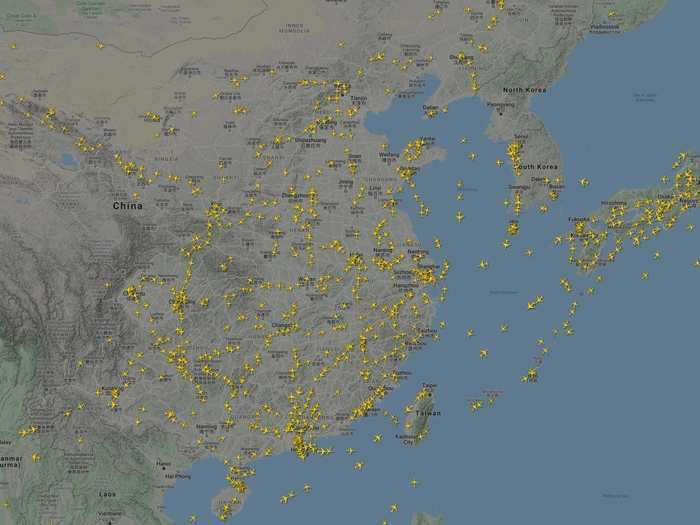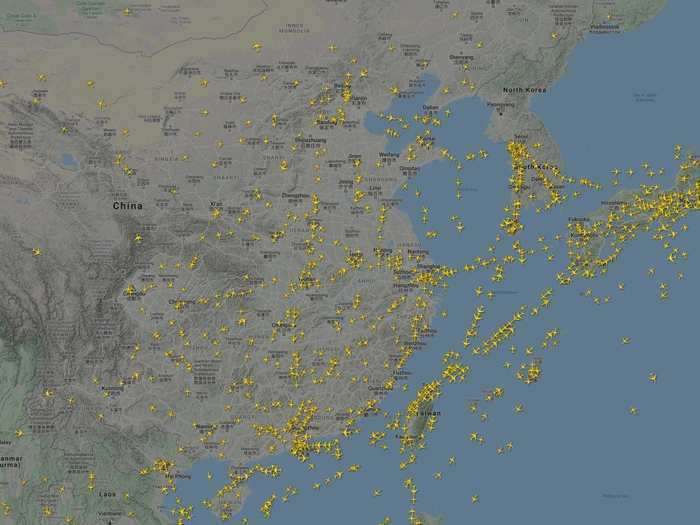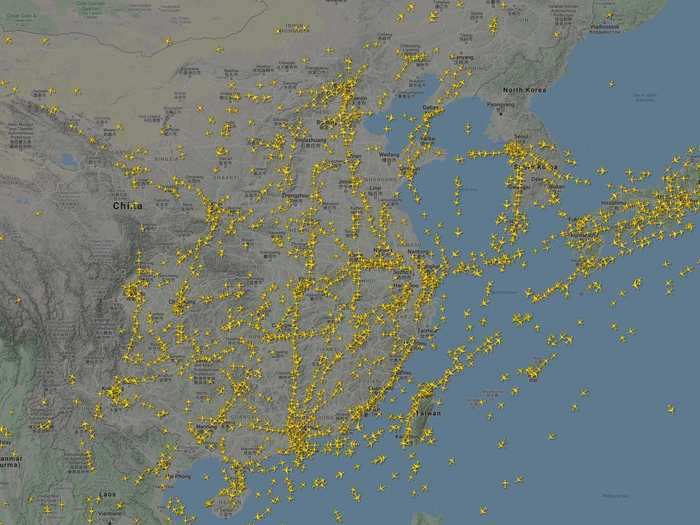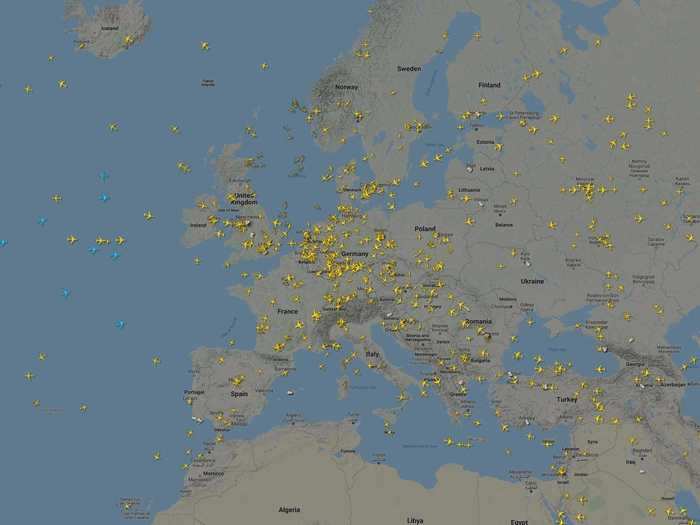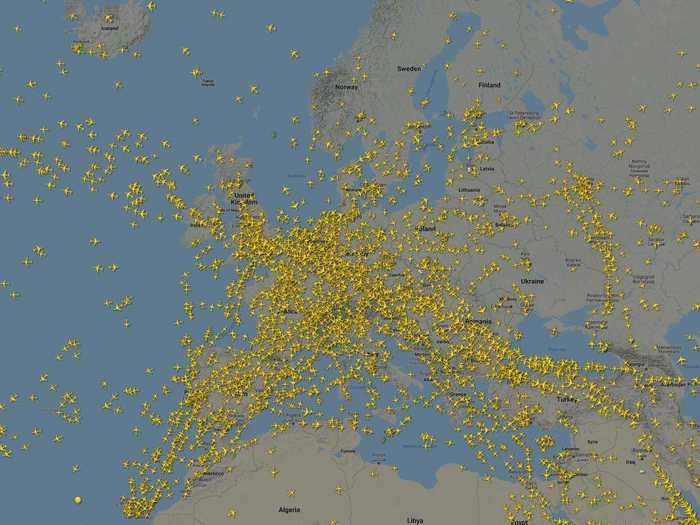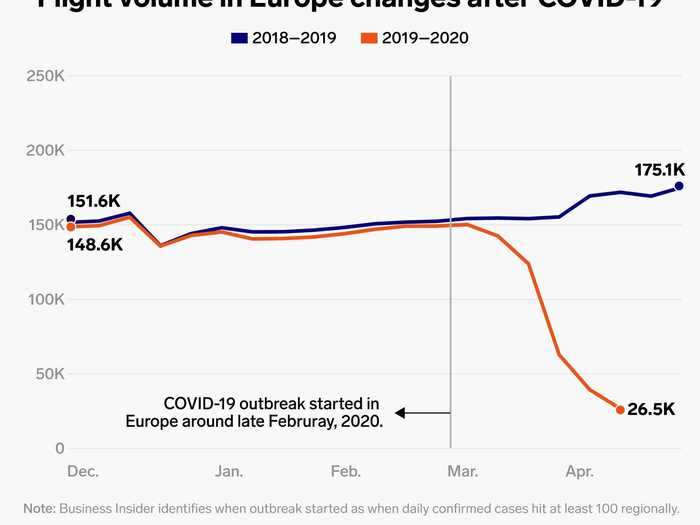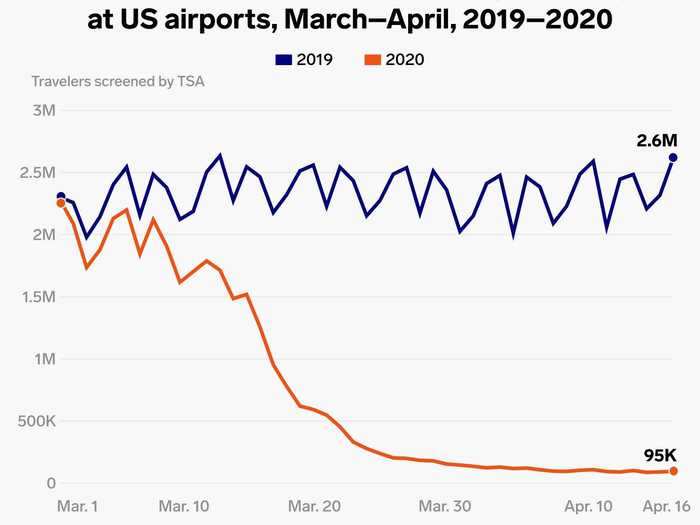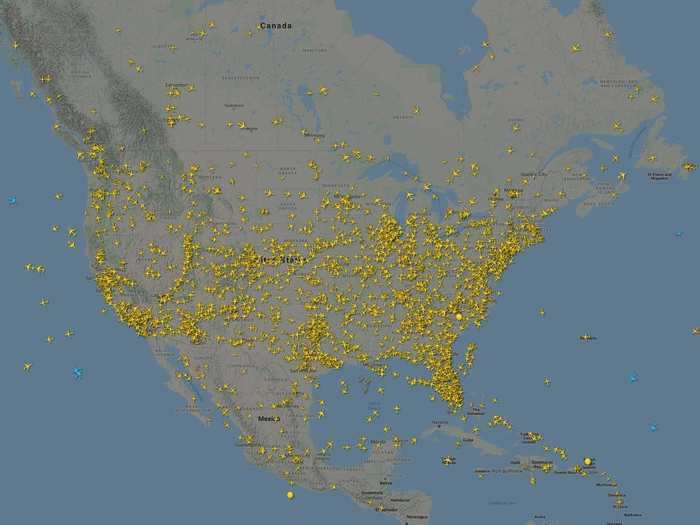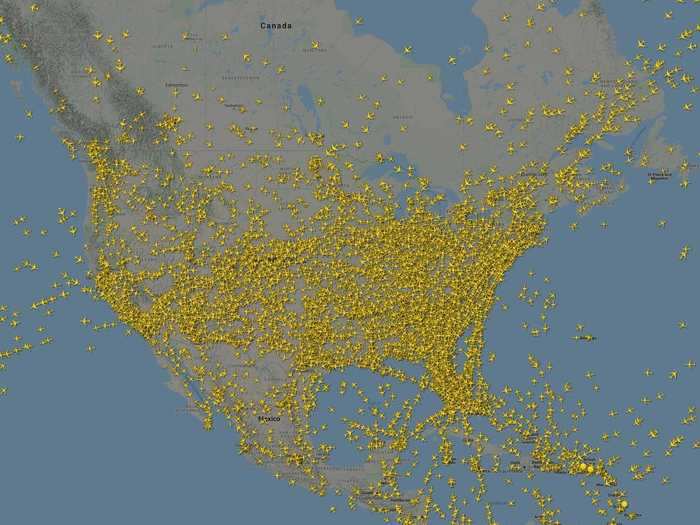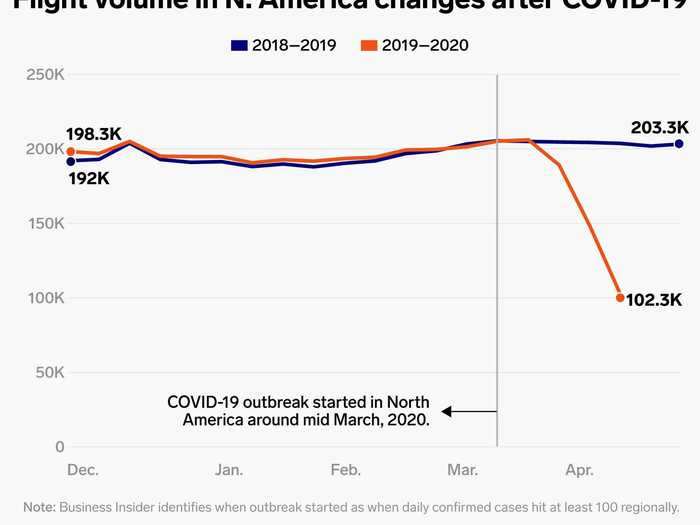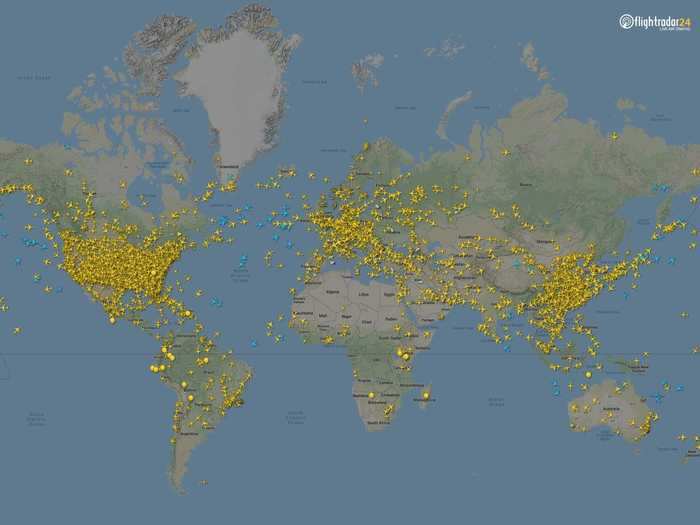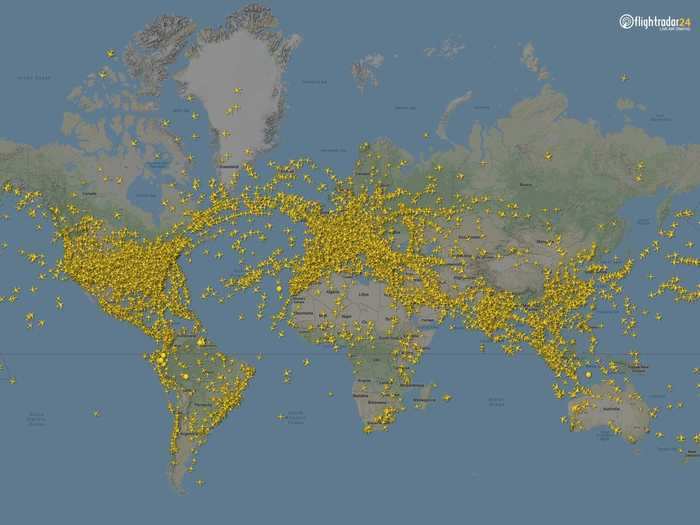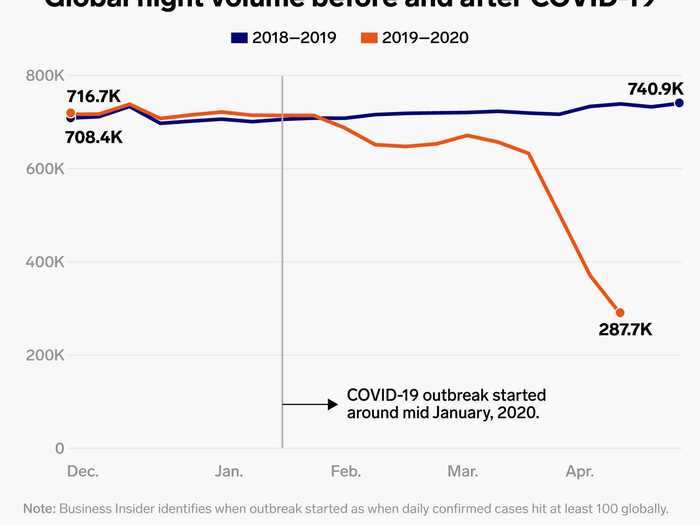Ruobing Su/Business Insider
- Demand for air travel has plummeted globally as the coronavirus pandemic continues to spread.
- Airlines are still operating at a reduced capacity, but they've grounded large portions of their fleets. They are routinely sending up planes with just one or two passengers, plus some cargo.
- We looked at data that shows just how empty the skies are these days, and what that drop means for air traffic around the world.
- Visit Business Insider's homepage for more stories.
The airline industry is undergoing the worst crisis in its history.
What three months ago looked like a possible minor headwind for first-quarter earnings has morphed, in just weeks, into a crisis with a great impact than the terror attacks of September 11, 2001, the 2008 financial crash, and virtually every other history altering event of the jet age combined.
The situation has become especially dire as new forecasts and models predict that it will be months, or possibly even years, before life returns to normal.
"This is the biggest crisis that the industry has ever faced," Alexandre de Juniac, director general of the International Air Transport Association (IATA) said in a statement. "The impact on aviation has left airlines with little to do except cut costs and take emergency measures in an attempt to survive in these extraordinary circumstances."
IATA, which represents about 290 airlines around the world, has said that the airline industry could lose $314 billion dollars due to the outbreak.
Airlines around the world have grounded large parts of their fleets, and suspended numerous flights and routes – United Airlines, for instance, said it had decreased its capacity by 90% for the May schedule.
However, there are still flights in the air. While many of them are mostly empty, airlines are maintaining essential connectivity amid the pandemic — something the US requires as part of a government aid package delivered to the industry.
Many passenger flights are also carrying freight in their cargo holds, and some are adapting planes to carry cargo in empty passenger cabins. Essential workers, such as volunteer healthcare providers and public health officials are also still flying, and cargo-only operators are moving supplies such as masks, ventilators, and more, keeping supply chains intact.
Still, the skies are much emptier than they used to be.
We've analyzed flight data from OAG, an aerospace data and consulting company, to see the real time impact of the coronavirus on air traffic. We've also looked at data from the Transportation Security Administration (TSA), and from FlightRadar24, a service that tracks global air traffic.
The data show just how quiet the skies have become, even as flights continue at reduced rates. Keep reading to see what the falloff looks like.
Read the original article on
Business Insider
... And April 7, here.
Air traffic over Asia on April 7, 2020, at 6 a.m. ET
Flightradar24
... February 7, 2020, here ...
Air traffic over Asia on February 7, 2020, at 5 a.m. ET
Flightradar24
The falloff in air traffic is a bit harder to see in the Asia region, just as a function of how the virus has spread. Still, there's a noticeable difference between January 7, 2020, here ...
Air traffic over Asia on January 7, 2020, at 5 a.m. ET
Flightradar24
The decrease in flights over Asia has been more staggered than in other regions, at least to date.
Ruobing Su/Business Insider
Traffic first began to fall sharply in early February, as the novel coronavirus first began to spread from China's Hubei province to the rest of the country, and the rest of Asia.
While traffic began recovering in late February and early March as China worked to contain the outbreak and other countries began to see success containing the spread of the virus, it has since begun to decrease again as lockdowns and efforts to contain the virus continue in other parts of the world.
In the first week of December 2019, there were 228,828 domestic, regional, and long-haul international flights that departed from Asia.
The first week of April 2020 saw that number dip to 109,906, a 52% drop.
In April 2019, the same week had 221,827 flights, representing a 50.5% decrease.
By April 7, commercial air traffic in the region was sparse.
Air traffic over Europe on April 7, 2020, at 11 a.m. ET
Flightradar24
The changes in Europe's air traffic over just a month are perhaps the most stark globally. On March 7, even as an outbreak in Italy was becoming more severe and the virus was spreading elsewhere, air traffic remained robust, despite a slight year-over-year drop.
Air traffic over Europe on March 7, 2020, at 10 a.m. ET
Flightradar24
Although flights are continuing in Europe, the falloff has been greater than in North America.
Ruobing Su/Business Insider
Over the first full week of December 2019, there were 148,632 flights departing within Europe.
The first week of April, 2020, as the coronavirus outbreak continued to ravage the region, there were just 26,484 flights, an 88.9% drop.
During the first week of April 2019, there were 169,352 flights in the Europe region, a roughly 84.4% decrease year-over-year.
What the continuation of commercial flights in the US masks is just how few people are flying on them.
Ruobing Su/Business Insider
The number of travelers passing through security checkpoints at US airports has fallen dramatically since the outbreak began.
On March 1, 2020, nearly 2.3 million travelers — including pilots and flight attendants — passed through checkpoints.
On April 16, 2020 that number was down to just 95,000 — a decrease of more than 96%, despite the total number of flights falling just 50%.
On the same day in 2019, more than 2.6 million travelers took to the skies in the US.
The numbers reported by the TSA align with reports from US airlines — United, for instance, said it was flying 97% fewer passengers than the same period last year.
By early April, traffic had thinned considerably. The falloff in North America hasn't been quite as severe as some other regions, partly because the US government has mandated that airlines maintain a minimum level of connectivity in order to be eligible for federal assistance.
Air traffic over North America on April 7, 2020, at 2 p.m. ET
Flightradar24
The requirement under the CARES Act is designed to keep supply chains stable and transport essential personnel, like government and healthcare workers, as well as to maintain connectivity to smaller areas.
Without commercial flights continuing, "federal and state government agencies would need to charter as many as thousands of flights daily, at far greater cost than CARES Act grants," Robert Mann, a consultant and former airline executive, previously told Business Insider.
Planes are continuing to fly in other countries, as well, maintaining services and routes either as requested by governments or as it makes sense for them based on commercial factors.
Just like in the global map, air traffic over North America appeared healthy on March 7, even as the outbreak was spreading and people were cancelling travel to Asia and Europe.
Air traffic over North America on March 7, 2020, at 1 p.m. ET
Flightradar24
Although North America looks the least affected in the above maps, there's a clear falloff when you take a closer look.
Ruobing Su/Business Insider
During the first week of December 2019 — just before the peak of the holiday travel period, there were 198,290 flights in North America, again measured in terms of departures.
By the first week or April 2020 that was down to just 102,319. That's a decrease of 48.4%.
The same week in April 2019 saw 204,297 flights, meaning that the total number of flights has fallen about 50% year-over-year.
Exactly one month later, on April 7, 2020, traffic was down substantially.
Air traffic around the world on April 7, 2020, at 11 a.m. ET
Flightradar24
A cursory look at Flightradar24 shows how much things have changed in just one month. This is a screenshot of global commercial air traffic on March 7, 2020.
Air traffic around the world on March 7, 2020, at 10 a.m. ET
Flightradar24
The falloff in global commercial air traffic has been steep and severe.
Ruobing Su/Business Insider
The first full week of December 2019 saw 716,727 commercial flights — measured by total departures — around the world, according to OAG.
Just four months later, during the first full week of April 2020, there were only 287,760 flights. That's a decrease of nearly 59.8%.
That same week in April 2019 saw 733,576 flights — the total number of flights fell 60.8% year-over-year.

